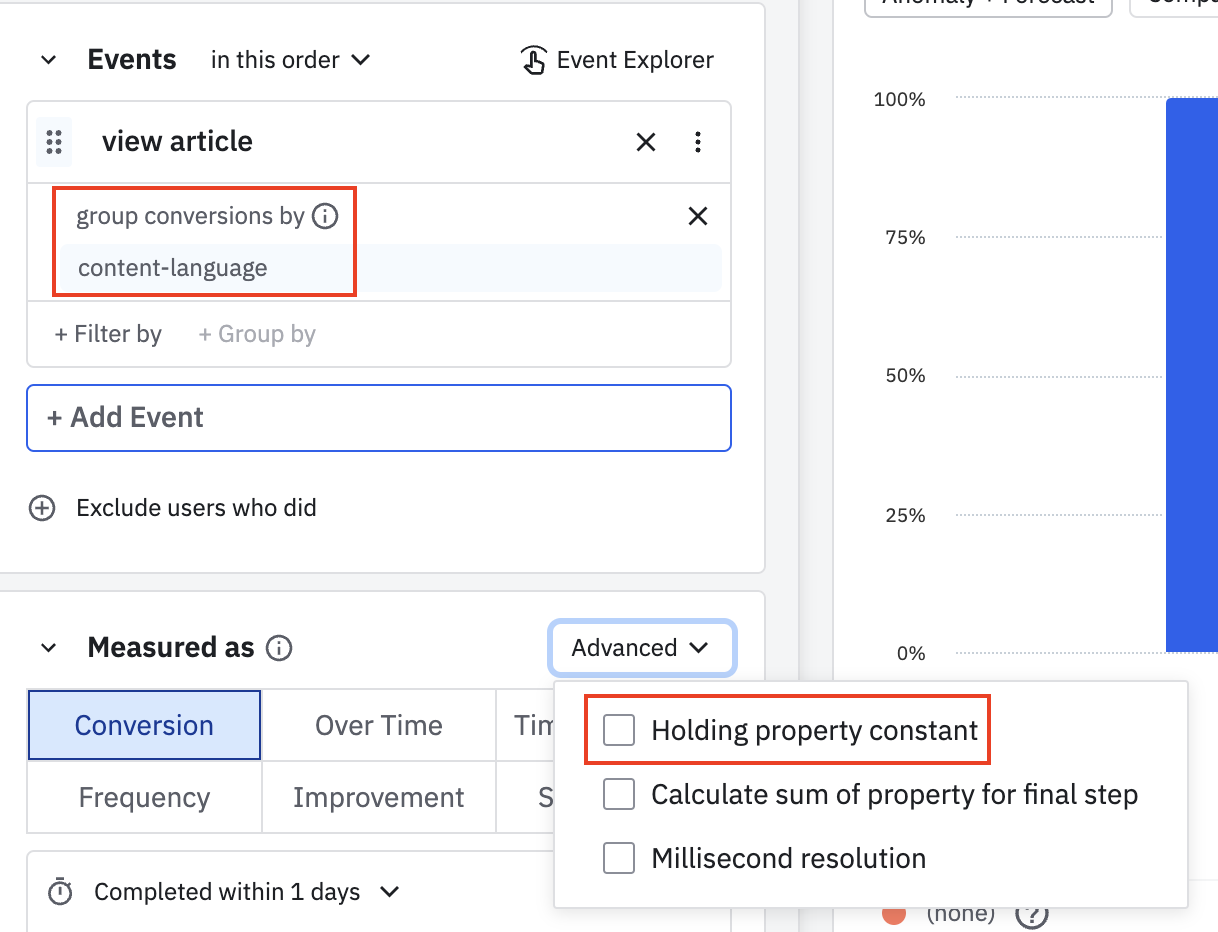How Amplitude computes conversions through funnels
This article helps you:
Familiarize yourself with conversion computations using funnels
Identify key differences between Funnel and Event Segmentation charts
Identify key differences between Funnel and Event Segmentation charts
When calculating conversion for a funnel in which users can complete the steps more than once, Amplitude will bucket each user based on the values tied to the first occurrence of each event.

Understanding these implications is vital in drawing accurate conclusions from your analyses.
First-touch attribution scenarios
Let's assume we have a funnel to track registrations (complete registration) broken down by the landing page each user sees (view landing page). If we hold constant by session_id, users must complete both steps of the conversion process in the same session in order for Amplitude to count them as converted.
Scenario 1: Funnels using both Hold property constant and group conversions by
When a funnel analysis uses both the hold constant and broken down by functions, Amplitude bases conversion on the earliest entry within the session.
Consider the following events and conversion results as examples:
| Events | Conversion |
|---|---|
| A user sees Landing Page A and completes registration within the same session. | The session counts as converted, and the conversion is attributed to Landing Page A. |
| A user sees Landing Page A, then Landing Page B in the same session, but converts only after seeing Landing Page B. | Since that user saw Landing Page A first, the conversion within the session would be attributed to Landing Page A. |
| A user sees Landing Page A, then Landing Page B in different sessions. | That user does not convert in the session where they saw Landing Page A. But, that same user does convert in the session where they saw Landing Page B. Amplitude will count the Landing Page A session as not converted, and the Landing Page B session as converted. |
Note
Scenario 2: Funnels using group conversions by, but not Hold property constant
In cases where only the broken down by function is used, Amplitude bases conversion on the earliest entry within the lookback window.
Users are grouped by the first landing page they saw within the lookback window (how they entered the funnel). They'll be considered converted if they trigger the final event within the duration of the conversion window.
For example, let's consider the following events and related conversions:
| Events | Conversion |
|---|---|
| A user sees Landing Page A and completes registration within the conversion window. | That user counts as converted, and the conversion is attributed to Landing Page A. |
| A user sees Landing Page A, then Landing Page B, and completes registration within the window for Landing Page A. | That user counts as converted, and the conversion is attributed to Landing Page A, since they saw that one first. |
| A user sees Landing Page A, then Landing Page B, but does not convert. | That user counts as not converted. The events negatively affect Landing Page A's performance, but do not count against Landing Page B. |
Note
The logic of unique user counts in funnel analyses
When counting by unique users, the baseline conditions for conversion are:
- A user must be eligible for inclusion into the funnel: The user cannot be filtered out from consideration via the user segmentation panel. Any filters set in the Segment by module only apply at the time that the user triggered the first funnel event.
- A user must enter the funnel and complete all steps in the conversion window: The user must enter the funnel, and complete all steps of the funnel within the stated conversion window to count as converted in the final funnel step. Otherwise, the user will be counted based on how far they progressed through the funnel.
Further, when Amplitude is counting by uniques, it will only count the earliest and longest conversion for each unique user:
- Longest: In this context, longest means the most complete conversion; i.e., the completion of the most required steps within the funnel.
If Amplitude finds multiple conversions meeting the longest definition, it selects the first one and counts that as when conversion occurred.
- Earliest: Amplitude measures earliest using the first converting sequence chronologically, if there is more than one.
When using the broken down by function, Amplitude continues to use the longest/earliest logic to bucket users in accordance with the property that was present at their point of funnel entry.
If you're using Hold constant by in your analysis, Amplitude will look for the longest/earliest converting sequence within the same user session. When doing so, the unit of measurement changes to unique user and session ID pairings.
However, when counting by event totals, the earliest/longest logic does not apply. Instead, Amplitude considers all conversion paths taken or attempted, rather than just the earliest/longest path per user. The paths are then attributed to the property for the event in the step it was broken down by.
Funnels versus event segmentation
The Funnel and Event Segmentation charts provide different types of analyses, and as such, could display differing results. The following table highlights some of those differences:
| Funnel | Event Segmentation |
|---|---|
| Shows steps a user takes to gauge experience | Shows what events users are triggering |
| Filters only apply to the first step | Filters apply to every event |
| User must execute step 1 to enter funnel | No funnel to enter |
December 19th, 2025
Need help? Contact Support
Visit Amplitude.com
Have a look at the Amplitude Blog
Learn more at Amplitude Academy
© 2025 Amplitude, Inc. All rights reserved. Amplitude is a registered trademark of Amplitude, Inc.